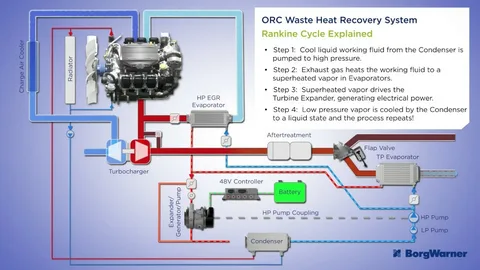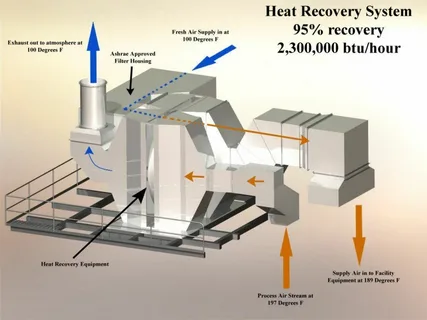Are you looking to enhance the air quality and energy efficiency in your living space? Look no further than heat recovery system. These innovative systems offer a range of benefits for both homes and offices, making them a popular choice for those seeking to create a healthier and more sustainable indoor environment. In this blog post, we will explore the key features, benefits, and installation of heat recovery ventilation systems, as well as real-life success stories showcasing their effectiveness.
Understanding Heat Recovery Ventilation Systems
Heat recovery ventilation (HRV) systems represent a pivotal advancement in domestic and commercial building services, engineered to maintain optimal air quality whilst championing energy conservation. Central to their design is the principle of heat exchange. HRV systems ingeniously reclaim heat from outgoing stale air and transfer it to the incoming fresh air. This ensures that the indoor environment remains well-ventilated without the penalty of increased heating or cooling costs.
The operation of these systems is both straightforward and sophisticated. Through a network of ducts, stale, humid air is extracted from kitchens and bathrooms, passing through a heat exchanger before being expelled outside. Simultaneously, fresh air is drawn in from the outdoors, warmed by the heat exchanger using the energy recovered from the outgoing air, and then distributed throughout the building. This cyclical process not only maintains a constant, comfortable temperature but also significantly reduces the levels of indoor pollutants and allergens.
What sets HRV systems apart is their ability to fine-tune the balance between energy efficiency and air quality, thanks to advanced technologies that regulate airflow and temperature. This adaptability makes them an ideal solution for a wide range of climates and building types, providing a healthier living and working environment without compromising on energy use or comfort.
 The Benefits of Installing a Heat Recovery Ventilation Unit in Your Home or Office
The Benefits of Installing a Heat Recovery Ventilation Unit in Your Home or Office
You are embarking on installing a heat recovery ventilation unit within your dwelling or workplace ushers in a plethora of advantages geared towards enhancing the ambience and healthfulness of your indoor environment. One of the standout benefits is the marked reduction in humidity levels, which significantly mitigates the risk of condensation and mould accumulation – common culprits behind structural damage and health issues. Furthermore, these systems are instrumental in dispelling stale and odorous air, ensuring that your space remains fresh and inviting.
An often underappreciated yet vital advantage is the improvement in thermal comfort these units bring about. By continuously supplying your space with filtered, fresh air that is at or near your preferred temperature, the need for traditional heating or cooling is lessened. This makes for a more comfortable living or working environment and contributes to a notable decrease in energy expenditure.
Moreover, the introduction of a heat recovery acts as a shield against outdoor pollutants and allergens, thanks to its sophisticated filtration system. This feature is particularly beneficial for individuals suffering from respiratory conditions or allergies, as it fosters a cleaner, healthier indoor air quality.
In sum, the adoption of a heat recovery ventilation within your home or office not only elevates the quality of your indoor air but also brings about energy savings, health benefits, and an overall enhancement in the comfort and wellbeing of occupants.
Key Features to Look For in Top-Quality Heat Recovery Exchanger
Discerning the attributes that constitute a superior model is pivotal when delving into the market for a heat recovery ventilation system. Paramount among these is the efficiency rating of the heat exchanger itself. Models boasting high-efficiency ratings are adept at transferring warmth from outgoing air to incoming air, ensuring that energy conservation is maximised. Equally critical is the system’s ability to operate at variable fan speeds. This flexibility allows the unit to adjust airflow according to the specific needs of the space, enhancing both comfort and efficiency.
Furthermore, the integration of advanced filtration mechanisms within the system cannot be overstated. A top-quality heat recovery exchanger should be equipped with filters capable of capturing a broad spectrum of airborne contaminants, from fine particulates to more significant allergens. This feature is instrumental in safeguarding the respiratory health of occupants and maintaining pristine indoor air quality.
Another aspect worth considering is the ease of maintenance and accessibility of the unit. Systems with user-friendly access to filters and other components simplify regular maintenance tasks, ensuring prolonged efficiency and performance.
Lastly, noise levels produced by the system play a crucial role in user satisfaction. Opt for models that emphasise quiet operation, eliminating any potential disturbance to the living or working environment.
By prioritising these key features, individuals can make an informed decision, securing a heat recovery ventilation system that epitomises efficiency, air quality, and operational excellence.
How HRV Systems Improve Indoor Air Quality
One of the standout capabilities of heat recovery ventilation (HRV) systems is their efficacy in bolstering indoor air quality. These systems operate on a simple yet profound principle: facilitating the constant exchange of stale, contaminated indoor air with fresh, clean outdoor air. The process is seamless and efficient, ensuring that the indoor environment is perpetually replenished with air that is free from pollutants and allergens.
Central to their operation, HRV systems incorporate a sophisticated filtration mechanism that plays a pivotal role in purifying incoming air. This means that not only is the air brought into your living or workspace fresh, it also undergoes filtration to remove particulate matter and other airborne contaminants. Such a comprehensive approach to air exchange and filtration is particularly beneficial for individuals with allergies or respiratory conditions, as it significantly reduces the presence of irritants in the air.
Moreover, the constant introduction of fresh air and extraction of stale air helps to prevent the buildup of humidity, further contributing to a reduction in the potential for mould growth and maintaining an environment that supports respiratory health. By prioritising indoor air quality through such advanced ventilation strategies, HRV systems underscore the importance of creating a healthy and comfortable indoor atmosphere.
The Role of Heat Recovery Unit in Energy Efficiency
A crucial aspect of heat recovery unit that warrants attention is their capacity to enhance the energy efficiency of buildings significantly. These systems adeptly reclaim warmth from exhaust air, diminishing the demand for additional heating or cooling. This process not only ensures a sustainable energy usage but also contributes to considerable savings on utility bills. By capturing and re-utilising heat that would otherwise be lost to the outside, these units operate as an eco-friendly solution, lowering the overall energy consumption of a property.
Moreover, the advanced technology employed allows for the precise control of airflow and temperature, ensuring that energy is not wasted and that the indoor climate remains consistently comfortable without excessive external heating or cooling sources. This alignment of comfort with energy conservation highlights heat recovery ventilation units’ vital role in promoting a more sustainable and cost-effective approach to managing indoor environments. Their contribution to reducing a building’s carbon footprint further accentuates their importance in pursuing greener, more energy-efficient living and working spaces.
Installation and Maintenance: What You Need to Know about heat energy recovery system
Embarking on installing a heat energy recovery system demands meticulous planning and expertise to ensure that the setup is optimised for your specific living or working environment. Engaging with professionals who possess a deep understanding of these systems is crucial. They will thoroughly assess your premises, considering factors such as building size, layout, and existing ventilation to design a system tailored to your needs. The installation process itself involves integrating the system into your building’s architecture, requiring modifications to ductwork and ensuring seamless operation with existing heating and cooling systems.
Maintenance is equally important to preserve the efficiency and longevity of your heat recovery. Regular check-ups should focus on inspecting ducts, cleaning or replacing filters, and ensuring that the heat exchanger is free from debris that could hinder performance. Manufacturers typically provide guidelines on maintenance schedules; however, engaging a professional for annual inspections can preemptively address potential issues, ensuring your system operates at peak efficiency.
It’s essential to note that neglecting maintenance can lead to reduced air quality and efficiency, potentially counteracting the system’s benefits. Therefore, a proactive approach to upkeep is advisable to maintain an optimal indoor environment and secure the investment in your heat recovery.
Real-Life Success Stories: HRV Systems in Action
Across the globe, countless households and businesses have witnessed remarkable transformations after integrating heat recovery ventilation (HRV) systems into their properties. One such narrative emerges from a residential community in the North, where homeowners faced relentless battles against condensation and mould due to their region’s chilly, damp climate. Following the installation of an HRV system, not only was the mould issue eradicated, but residents also reported a noticeable improvement in their home’s warmth and air freshness, alongside a reduction in heating costs.
Another testament comes from a bustling office environment in a metropolitan area plagued by stale air and frequent employee health complaints linked to poor air quality. The introduction of an HRV system led to a significant decrease in employee sick days, attributed to the enhanced indoor air quality and reduction of airborne pollutants. The office now enjoys a reputation for a healthier, more refreshing workspace, which has also contributed to improved staff morale and productivity.
These accounts exemplify the tangible benefits HRV systems deliver, extending beyond energy savings to profoundly impact health, comfort, and well-being. They are a compelling endorsement for considering heat recovery ventilation as a pivotal component of modern living and working environments.
Conclusion
The exploration of heat recovery ventilation systems throughout this discussion illuminates their indispensable role in modern domestic and commercial settings. Emphasising energy conservation whilst enhancing the air quality within interiors, these systems stand out as a holistic solution to the everyday challenges of maintaining a comfortable, healthy, and sustainable environment. The ability to seamlessly integrate into various building types and adaptability to different climatic conditions underscores the versatility and effectiveness of heat recovery ventilation units. Furthermore, the discussion highlights the importance of professional installation and diligent maintenance to ensure these systems deliver their full potential in performance and longevity.
FAQS
Q: Will installing an HRV system in my home make it noisy?
A: Contemporary HRV systems are engineered for silent operation, making noise levels minimal. Innovations in design mean that these systems can function effectively without disrupting the tranquillity of your home or office environment.
Q: How frequently do the filters in an HRV system need to be changed?
A: The frequency of filter replacement in your HRV system varies based on several factors, including the level of use and the external air quality. As a general guideline, it is advisable to inspect and possibly replace the filters every six to twelve months to ensure optimal performance. Regular maintenance checks will help determine the exact needs of your system.
Q: Is it possible for me to install an HRV system on my own, or should I seek professional help?
A: While it might be tempting to install an HRV system as a DIY project, enlisting the services of a professional is strongly recommended. The complexity of correctly integrating the system into your building to ensure it operates at peak efficiency requires specific skills and knowledge. Professional installation guarantees that your system is tailored to your building’s requirements, ensuring maximum effectiveness and avoiding potential issues that could arise from improper setup.
| Related Business Listings |
| Contact Directory |
| Local Business Profiles |



